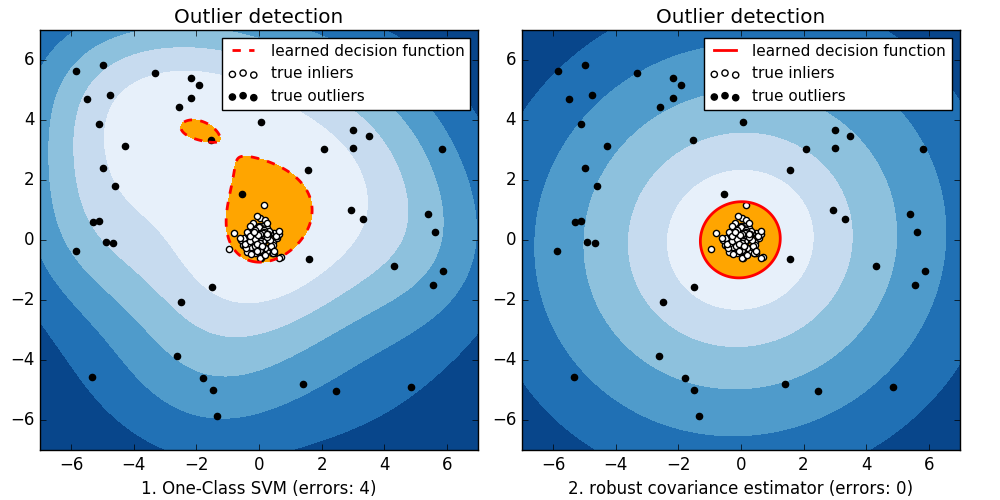【图像识别异常检测】:算法与应用的全方位指南
发布时间: 2024-09-06 12:12:19 阅读量: 404 订阅数: 103 


# 1. 图像识别异常检测概述
## 1.1 简介
异常检测是数据挖掘中的一项重要任务,目的在于识别出数据集中的不正常或异常的数据点。它在金融欺诈检测、网络入侵检测、故障诊断等领域都有广泛的应用。在图像识别领域,异常检测可以被用来识别出不符合正常模式的图像或图像序列,对于提高自动化监控系统的效率和准确性具有重大意义。
## 1.2 应用价值
图像识别异常检测在安防监控、自动驾驶、医疗影像分析等多个领域有着实际应用价值。例如,在自动驾驶中,通过实时监控交通环境,及时发现并响应道路上的异常情况,可以大大减少交通事故。在医疗影像领域,通过识别出病理图像中的异常模式,可以帮助医生更快地做出诊断。
## 1.3 技术挑战
尽管图像识别异常检测技术已经取得了长足的进步,但仍面临许多挑战。如数据不平衡问题,即正常样本的数量远远多于异常样本,使得模型训练难度加大。此外,不同的应用场景对检测精度、速度的要求不同,如何设计出普适性强的模型,是一个亟待解决的问题。
# 2. 图像识别技术的理论基础
### 2.1 图像处理的基本概念
数字图像处理是计算机视觉和图像识别的基石。在深入探讨其在图像识别中的应用之前,我们需要理解几个关键概念。
#### 2.1.1 数字图像的表示方法
数字图像由像素组成,这些像素是构成图像的最小单位,每个像素具有特定的值来表示颜色和亮度。图像可以是灰度图(单通道),其中像素值表示灰度级;也可以是彩色图(三通道),其中包含红、绿、蓝三个颜色通道的值。彩色图像的常见格式有RGB、HSV等。
##### 代码块分析
以Python语言为例,我们通常使用Pillow库来处理图像数据:
```python
from PIL import Image
# 打开一张彩色图片
img = Image.open('example.jpg')
# 将图片转换为灰度图
img_gray = img.convert('L')
# 保存灰度图
img_gray.save('example_gray.jpg')
```
在这段代码中,`Image.open`用于打开图片文件,`convert`函数将图片从RGB格式转换为灰度图('L'代表灰度图)。这是处理图像前的基本步骤,有助于减少计算复杂性。
#### 2.1.2 常用图像处理技术
图像处理包括图像增强、滤波、边缘检测、形态学操作等。例如,直方图均衡化是一种常用的图像增强技术,它可以改善图像的全局对比度。
##### 代码块分析
使用OpenCV库进行直方图均衡化的代码示例如下:
```python
import cv2
import numpy as np
# 读取图片
image = cv2.imread('example.jpg')
# 转换为灰度图
gray_image = cv2.cvtColor(image, cv2.COLOR_BGR2GRAY)
# 应用直方图均衡化
equalized_image = cv2.equalizeHist(gray_image)
# 显示结果
cv2.imshow('Original Image', gray_image)
cv2.imshow('Equalized Image', equalized_image)
# 等待按键后关闭窗口
cv2.waitKey(0)
cv2.destroyAllWindows()
```
在这段代码中,`cv2.imread`用于读取图像,`cv2.cvtColor`用于颜色空间转换,`cv2.equalizeHist`用于进行直方图均衡化。这是一种基础图像处理技术,适用于提高图像的可视化效果。
### 2.2 机器学习在图像识别中的应用
#### 2.2.1 机器学习算法简介
机器学习算法包括监督学习、无监督学习、半监督学习和强化学习。在图像识别中,基于这些算法的分类器或回归模型可以被训练来识别图像中的模式。
##### 代码块分析
下面是一个使用Scikit-learn库实现支持向量机(SVM)分类器进行图像分类的简单例子:
```python
from sklearn import svm
from sklearn.model_selection import train_test_split
from sklearn.metrics import classification_report
# 假设X是图像特征集,y是对应的标签
X_train, X_test, y_train, y_test = train_test_split(X, y, test_size=0.2)
# 创建SVM分类器实例
clf = svm.SVC()
# 训练模型
clf.fit(X_train, y_train)
# 预测测试数据
y_pred = clf.predict(X_test)
# 输出评估结果
print(classification_report(y_test, y_pred))
```
在上述代码中,`train_test_split`将数据集分为训练集和测试集,`svm.SVC`创建了一个支持向量分类器,`fit`方法用于训练模型,而`predict`方法用于在测试集上进行预测。
#### 2.2.2 特征提取与选择
特征提取是将图像数据转换为机器学习算法可以处理的数值特征的过程。常用的图像特征包括HOG(方向梯度直方图)、SIFT(尺度不变特征转换)、ORB(Oriented FAST and Rotated BRIEF)等。
##### 表格分析
下面的表格展示了常用特征提取方法的优缺点:
| 特征方法 | 优点 | 缺点 |
| --- | --- | --- |
| HOG | 可以较好地描述图像的边缘和形状信息 | 对光照和阴影变化较为敏感 |
| SIFT | 描述符具有旋转不变性和尺度不变性 | 计算复杂,专利限制 |
| ORB | 计算效率高,免费使用 | 描述符的不变性比SIFT略差 |
#### 2.2.3 训练模型与评估指标
模型训练完毕后,需要对其进行评估以确定其性能。常用的评估指标有准确率(Accuracy)、精确率(Precision)、召回率(Recall)和F1分数(F1 Score)。
##### 代码块分析
```python
from sklearn.metrics import accuracy_score, precision_score, recall_score, f1_score
# 继续使用上节代码中的clf和y_pred
# 计算准确率
accuracy = accuracy_score(y_test, y_pred)
# 计算精确率
precision = precision_score(y_test, y_pred, average='weighted')
# 计算召回率
recall = recall_score(y_test, y_pred, average='weighted')
# 计算F1分数
f1 = f1_score(y_test, y_pred, average='weighted')
print(f'Accuracy: {accuracy}, Precision: {precision}, Recall: {recall}, F1 Score: {f1}')
```
在上述代码中,`accuracy_score`、`precision_score`、`recall_score`和`f1_score`分别计算了模型的准确率、精确率、召回率和F1分数,这些都是评估分类模型性能的常用指标。
### 2.3 深度学习在图像识别中的突破
#### 2.3.1 卷积神经网络(CNN)原理
卷积神经网络(CNN)是深度学习中一种特别适合图像识别的网络结构。它通过卷积层、池化层和全连接层的组合来学习图像的层次化特征。
##### 代码块分析
下面是一个使用Keras框架构建简单CNN模型的示例代码:
```python
from keras.models import Sequential
from keras.layers import Conv2D, MaxPooling2D, Flatten, Dense
# 构建序贯模型
model = Sequential()
# 添加卷积层和池化层
model.add(Conv2D(32, (3, 3), activation='relu', input_shape=(64, 64, 3)))
model.add(MaxPooling2D(pool_size=(2, 2)))
# 展平层将二维数据转为一维
model.add(Flatten())
# 添加全连接层
model.add(Dense(64, activation='relu'))
# 输出层
model.add(Dense(10, activation='softmax'))
# 编译模型
***pile(loss='categorical_crossentropy', optimizer='adam', metrics=['accuracy'])
# 模型概况
model.summary()
```
在这段代码中,我们构建了一个简单的CNN模型,包含了卷积层、池化层、全连接层以及最终的分类层。`model.summary()`用于输出模型的概况,包括每层的输出形状和参数数量。
#### 2.3.2 深度学习框架与实践
深度学习框架如TensorFlow、PyTorch为实现复杂的神经网络模型提供了便利。在实践中,从数据预处理到模型训练再到模型部署,这些框架都提供了全面的支持。
##### 代码块分析
这里用PyTorch框架定义一个简单的CNN模型:
```python
import torch
import torch.nn as nn
import torch.nn.functional as F
# 定义CNN模型
class SimpleCNN(nn.Module):
def __init__(self):
super(SimpleCNN, self).__init__()
self.conv1 = nn.Conv2d(3, 32, kernel_size=3, padding=1)
self.conv2 = nn.Conv2d(32, 64, kernel_size=3, padding=1)
self.fc1 = nn.Linear(64 * 16 * 16, 512)
self.fc2 = nn.Linear(512, 10)
def forward(self, x):
x = F.relu(self.conv1(x))
x = F.max_pool2d(x, 2)
x = F.relu(self.conv2(x))
x = F.max_pool2d(x, 2)
x = x.view(x.size(0), -1) # 展平
x = F.relu(self.fc1(x))
x = self.fc2(x)
return x
# 模型实例化
model = SimpleCNN()
# 设备设置,例如使用GPU
device = torch.device("cuda" if torch.cuda.is_available() else "cpu")
model.to(device)
# 模型概况
print
```
0
0





